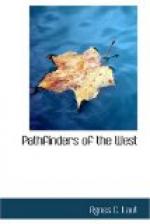[5] One can guess that a man who wrote in that spirit two centuries before the French Revolution would not be a sycophant in courts,—which, perhaps, helps to explain the conspiracy of silence that obscured Radisson’s fame.
[6] My reason for thinking that this region was farther north than Minnesota is the size of the Cree winter camp; but I have refrained from trying to localize this part of the trip, except to say it was west and north of Duluth. Some writers recognize in the description parts of Minnesota, others the hinterland between Lake Superior and James Bay. In the light of the memoire of 1696 sent to the French government, I am unable to regard this itinerary as any other than the famous fur traders’ trail between Lake Superior and Lake Winnipeg by way of Sturgeon River and the Lake of the Woods.
[7] Radisson Relations, p. 207.
[8] We are now on safe ground. There was a well-known trail from what is now known as the Rat Portage region to the great Sioux camps west of the Mississippi and Red River valleys. But again I refuse to lay myself open to controversy by trying definitely to give either the dates or exact places of this trip.
[9] If any proof is wanted that Radisson’s journeyings took him far west of the Mississippi, these details afford it.
[10] Radisson’s Journal, pp. 224, 225, 226.
[11] Mr. A. P. Low, who has made the most thorough exploration of Labrador and Hudson Bay of any man living, says, “Rupert River forms the discharge of the Mistassini lakes . . . and empties into Rupert Bay close to the mouth of the Nottoway River, and rises in a number of lakes close to the height of land dividing it from the St. Maurice River, which joins the St. Lawrence at Three Rivers.”
[12] Les Compagnies de Colonisation sous l’ancien regime, by Chailly-Bert.
[13] Oldmixon says: “Radisson and Groseillers met with some savages on the Lake of Assiniboin, and from them they learned that they might go by land to the bottom of Hudson’s Bay, where the English had not been yet, at James Bay; upon which they desired them to conduct them thither, and the savages accordingly did it. They returned to the Upper Lake the same way they came, and thence to Quebec, where they offered the principal merchants to carry ships to Hudson’s Bay; but their project was rejected.” Vol. I, p. 548. Radisson’s figures are given as “pounds “; but by “L” did he mean English “pound” or French livre, that is 17 cents? A franc in 1660 equalled the modern dollar.
[14] The exact tribes mentioned in the Memoire of 1696, with whom the French were in trade in the West are: On the “Missoury” and south of it, the Mascoutins and Sioux; two hundred miles beyond the “Missisipy” the Issaguy, the Octbatons, the Omtous, of whom were Sioux capable of mustering four thousand warriors, south of Lake Superior, the Sauteurs, on “Sipisagny, the river which is the discharge of Lake Asemipigon” (Winnipeg), the “Nation of the Grand Rat,” Algonquins numbering two thousand, who traded with the English of Hudson Bay, De la Chesnaye adds in his memoire details of the trip from Lake Superior to the lake of the Assiniboines. Knowing what close co-workers he and Radisson were, we can guess where he got his information.




